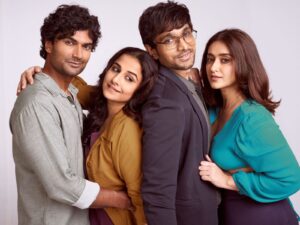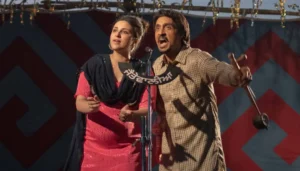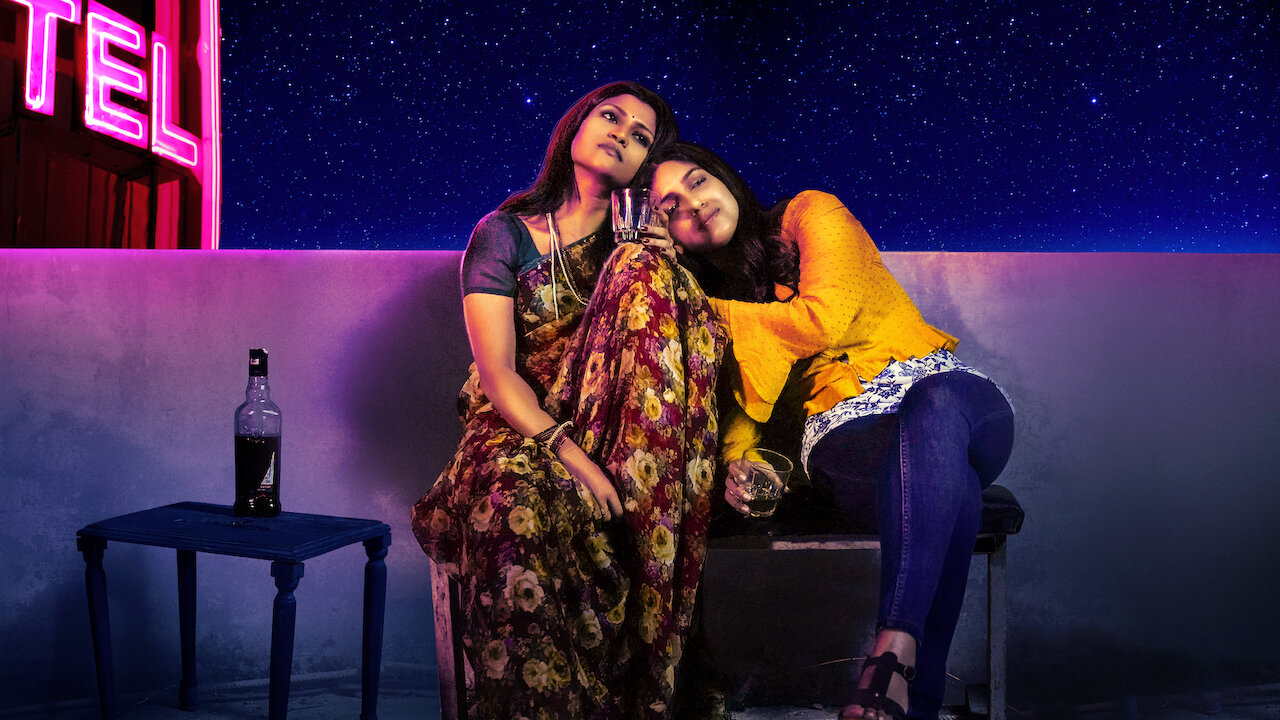
The most fascinating characters in Alankrita Shrivastava’s Dolly Kitty Aur Woh Chamakte Sitare are two children. They are Dolly’s (Konkona Sensharma) sons – Bharat (Hearty Singh) and Pappu (Kalp Shah). A regular school boy, Bharat loves sports and is someone who might grow up into what they call an ‘alpha male’. His name, this way, becomes a metaphor for the nation. Bharat’s younger brother Pappu is embarrassingly named for a reason. The little boy loves his dolls, make-up, and all things feminine. “I feel like a girl,” he states to his mother like how an adult would have.
Pappu’s mother is understandably perplexed. She didn’t prepare herself for a calamity of this order when she took to motherhood. The children’s father Amit (Aamir Bashir) is indifferent but somewhere he subtly puts the onus on his wife. With symbolic names, this family unit from Great Noida is emblematic of India in its entirety. Patriarchy and homophobia are not the only vices they unknowingly propagate. Dolly Kitty Aur Woh Chamakte Sitare packs in a lot more.
As the title suggests, Shrivastava’s film is equally about Kitty alias Kaajal (Bhumi Pednekar). Much like Sensharma’s impossibly dreamy ‘New Girl in the City’ from Wake Up Sid, Kaajal is also in search of a job. If we compare the scenario with Ayan Mukerji’s charming 2009 film, Kaajal never gets happiness home-delivered by sweet, handsome brats. Instead of an accidental friend, she tackles her brother-in-law’s lecherous advances. In place of Mrs D’Monte’s cosy apartment, Kaajal finds herself hunting for a bed in shady hostels. Instead of a Jazz-loving dreamboat employer, she tussles with a rude, pot-bellied man who threatens to slash her salary. Hailing from a middle-class (and backward caste) family from Bihar, Kaajal’s life is difficult in the booming city until she find a job at Red Rose Romance App.
At her workplace, Kaajal becomes Kitty. In what is a cross between Vidya Balan’s RJ in Tumhari Sulu and Mayu Matsuoka’s occupation in Shoplifters, it fetches Kaajal some of her basic essentials – a decent pay package, an air-conditioned office, and a free, filling meal. For Kaajal, Red Rose Romance App is not a permanent stop. It is a quick fix to her immediate worry – a decent livelihood.
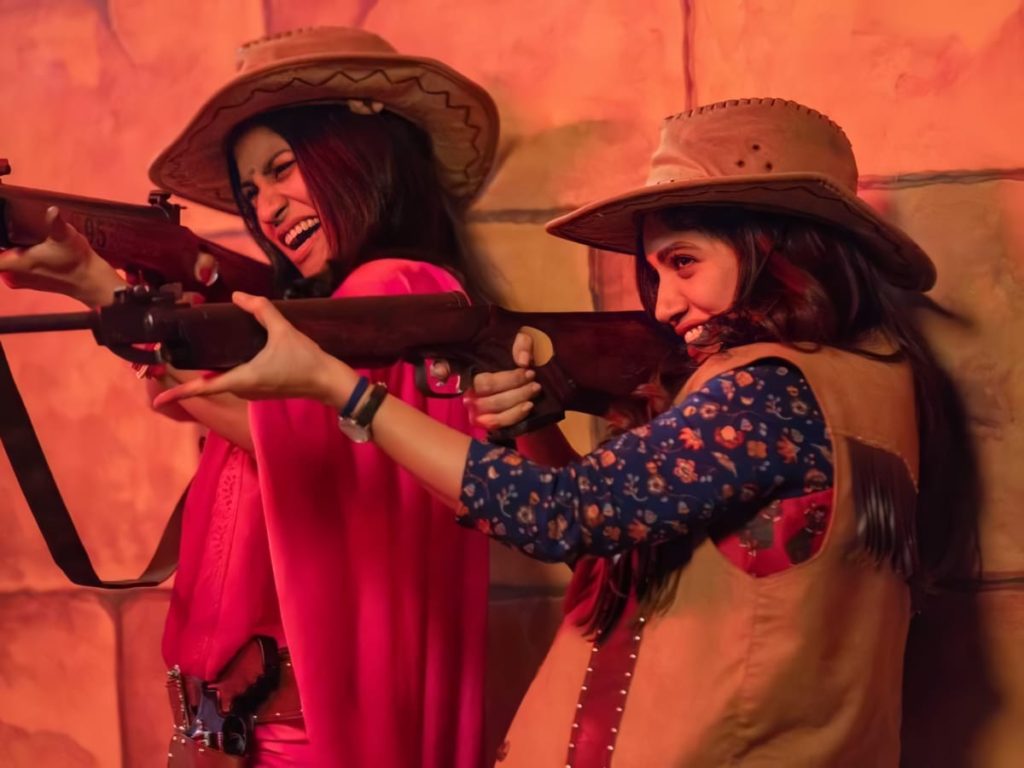
Life isn’t any better for her cousin Dolly. A victim of patriarchy, she faces it in the politest of ways at her workplace. Dolly’s otherwise decent boss would like to get his daily cup of tea from her. She, as if it were a woman’s moral duty to serve a man, obliges without helping herself even for once. Back home, we learn about her inactive sex life. We figure there is something amiss even though Amit is not an outright evil husband or an irresponsible father.
Enter two men in Dolly and Kitty’s lives. Dolly is attracted to a young college-going lad called Osman Ansari (Amol Parashar) who works at a restaurant chain called Ippy Foods. Kitty commits a professional faux pas by falling for the sweet-natured Pradeep (Vikrant Massey). Shrivastava interlaces both side-tracks with a shimmering original score (Mangesh Dhakde) which reminds us why the men were akin to whiffs of fresh air in Dolly and Kitty’s lives.
On paper, Dolly gets the trickier part. It takes us a while to understand her issues, including her sex life. The family is happy from the outside, is self-sufficient, and the couple has invested in a larger home. Soon we get a hint of Dolly’s unresolved mommy issues. In a fleeting moment of confusion, Dolly texts her mother – “Can I discuss something with you?” only to find her mom (Neelima Azeem, tremendous) at her doorstep the day after. Azeem’s character reminded me of Malayalam classic Ennu Swantham Janakikutty’s bold grandmother who had once eloped with her Tamilian lover. Dolly’s romance pales markedly in comparison. Massey’s Pradeep himself is the film’s most clichéd character. Even though the actor plays it very well, predictability ruins it for him. In fact, the film comes with other interesting men, albeit in tiny parts.
ALSO READ: ‘Lipstick Under My Burkha’ review – Brave film plants a ferocious slap on the face of patriarchy
Before we discuss men, there are smaller women characters in Dolly Kitty Aur Woh Chamakte Sitare who aren’t necessarily in search of anything. Kaajal’s hostel-mate Shazia (a wonderful Kubbra Sait) is a live-wire who introduces her to a lot of fun things including her boyfriend DJ Gujjar Number One (Karan Kundrra, well-cast). Dolly’s colleague June alias Juhi (Palveen Gujral) is a regular at swanky parties in the city. Then there is Nancy, the elderly mentor to Kitty at her workplace. She knits wool as she switches between the cheesiest of men.
Among its adult men, there is Amit who gets a sharply written part. Aamir Bashir (who is pitch-perfect) projects him in a fashion that he comes across as lustful but never blatantly vulgar. Dolly Kitty Aur Woh Chamakte Sitare does not paint him as a chronic womanizer either. Given a choice, he would rather have a steamy sex life with his wife. His inability to make Dolly fall in love with him is something Shrivastava’s film duly highlights. Dolly’s lover Osman, on the other hand, is everything Amit is not. He is sensitive, caring, and with him Dolly never feels sex is a chore. In a lovingly developed character, Parashar gets a handful of moments to shine. The virginal young man is the biggest catalyst in Dolly realizing everything that is wrong with her life. Complimenting him is DJ Gujjar and the equation he develops with Kaajal in the last act. Two of the above young men exist to actualize certain needs in Dolly and Kaajal’s lives – some emotional, some sexual. By portraying consenting adults the way they are in today’s age, Shrivastava makes sure to not objectify them in any way.
There is more to Dolly Kitty Aur Woh Chamakte Sitare’s screenplay besides the characters. In one of Pradeep and Kitty’s conversations around the word ‘flirting’, we are hinted about what she wants from him. Dolly’s character design as an under-confident mother is another brilliant touch. We know how she is bringing up her children also to prove a point to the society. She does not want to repeat her mother’s ‘mistakes’. This is Dolly’s way of patting her own back. There is a passing moment where Amit reads out a health magazine which serves sermons on motherhood but has nothing about fatherhood. Dolly’s solitary scenes with Pappu, though broad-stroked, are bold and much-needed in Indian cinema of today. Pappu himself is shown to be the more empathetic among the children. It is subtly underlined as we see him hand over a glass of Pepsi to his distressed aunt while his brother barely bothers. In another affecting instance, Kitty enters a cab driven by a chatty driver. Sobbing as a result of being violated, she requests the driver to play a devotional song – a quick fix that an ordinary middle-class person would do after a goof-up.
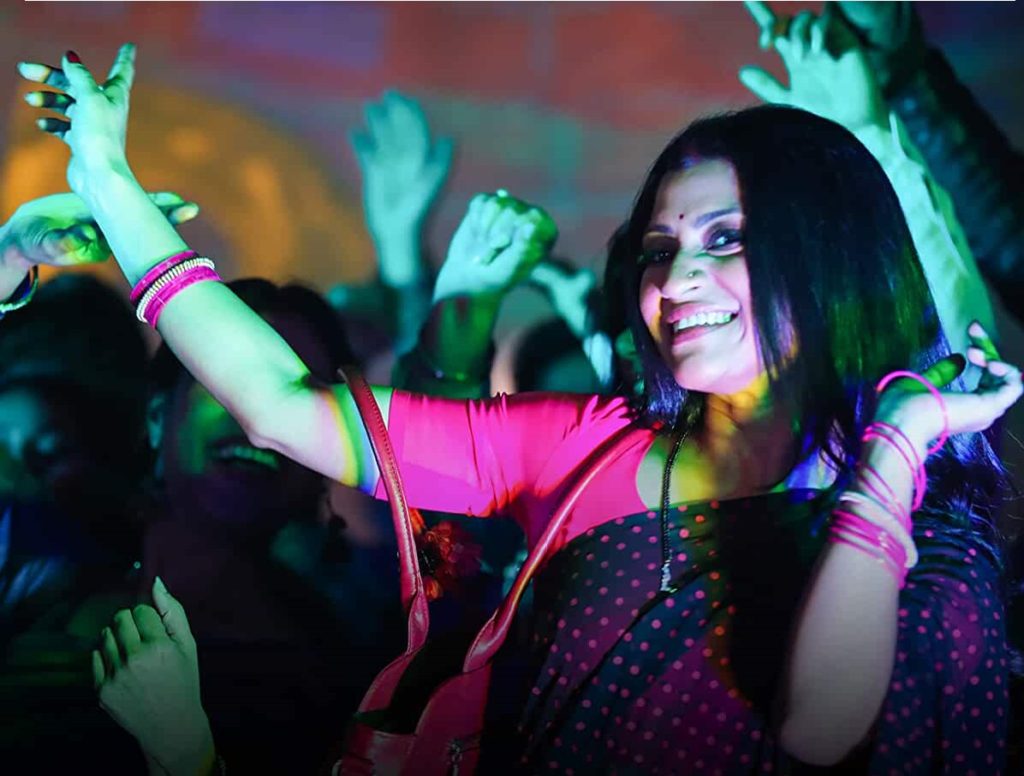
Dolly Kitty Aur Woh Chamakte Sitare is also a neat showcase of Shrivastava’s talent as a filmmaker. At her workplace, a disinterested Kitty is always shot through a transparent glass. Once she falls for Pradeep, we see her face through a tinted red glass. It’s all about the angles and Shrivastava, her DOP (John Jacob Payyapalli), and the editor (Charu Shree Roy) knew what they were doing. The director makes sure to establish her location (Greater Noida) and its unsafe nature for women. More than once in the film do we see a mini bus or tempo van approaching a female character at night – reminding us of the Nirbhaya incident. For a girl who goes through this every day, the Taj Mahal backdrop when Kitty meets Pradeep, therefore, becomes figurative. On a connecting note, the film also reasons why Pappu wants to dress up as Mumtaz Mahal and not Shah Jahan for a photo-op. Furthermore, through a transient shot staged inside the Doll Museum that Pappu badly wanted to visit, we observe the lack of a male doll – which gently drives home the point Shrivastava wants to make as far as the film’s gender/orientation-related conversation is concerned. The importance of ‘stars’ in the film’s title, too, stands established in the way they are placed in the women’s life. Though slightly melodramatic, the graveyard connect is an angle that perfectly closes one of their stories.
Dolly Kitty Aur Woh Chamakte Sitare is as much about its lead performances as it is about the writing and filmmaking. I do not know the last time I watched Sensharma in a full-length feature but watching her, at the cost of exaggerating, feels like a like comforting hug. To be more pointed about her interpretation of Dolly, she make sure the character is sold in the very first scene. Staged in an amusement park, Kitty says, “My brother-in-law desires me. He wants to have sex with me,” and Dolly’s face becomes a kaleidoscope of expressions. In a matter of seconds, we observe denial, confusion, distress, disappointment, orthodoxy, and speechlessness on Sensharma’s animated face. Shrivastava’s film reinforces why she is among the greatest actors Indian cinema has ever seen. Pednekar as Bhumi is outstanding as she makes us empathize with Kaajal as well as Kitty. While it is a sight to see her enact a sensuous song from Mr India to a perverted caller at the other end, the film also throws a cheekily meta scene where she schools a colleague about metabolism. Dum Laga Ke Haisha, anyone? Plus, I can’t appreciate her enough for the chapter with DJ Gujjar which begins with shy, telling glances in a hotel room she shares with him and Shazia.
ALSO READ: ‘Pause’ review – represents a generation of women and their silent agony
All its merits aside, Dolly Kitty Aur Woh Chamakte Sitare in no way is a flawless fare. Writer-director Shrivastava loses focus at various points and main reason for it is her decision to address a long list of issues. Equality in itself is a complex topic which the film confidently tackles. But Shrivastava wants to make a statement on Islamophobia and Hindu extremist groups. She inserts a track each on fraud realtors and materialistic women who pick rich NRIs over committed lovers. She wants one with an attractive girl who earns big bucks in exchange of a good time with middle-aged men.
Beneath all the clutter, Dolly Kitty Aur Woh Chamakte Sitare contains at least four tracks that can be developed into engaging spin-offs. Now with so many elements in place, the film isn’t an anthology either. Shrivastava is persistent to link them all in a pre-climax which goes completely haywire. The passage, singularly, brings the film several notches down. The activist angle involving a certain installation makes one crave for the sharp and intellectually stimulating last scene of Lipstick Under My Burkha. This climactic mayhem is something that we see approaching from a distance because half way through the film Shrivastava’s plot becomes complicated to a level of no escape.
To be honest, this is a film I wanted to love a little more. I wish it had the capacity to surprise me with the way it culminated. Then again, I should have realized that minimalism is not one of Shrivastava’s USPs going by her previous outings. But what I enjoyed the most in Dolly Kitty Aur Woh Chamakte Sitare are the interactions between its two leads. We needed more scenes (and films, for that matter) where two women lazily gulp alcohol in their building terrace to mouth impish lines such as, “Naya, naya aashiqui haina… whiskey ke saath”. (It’s my new love… whiskey) Bring them on.
